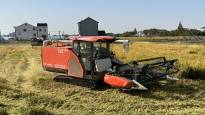FENG JING Clay and silt fly from Sarkaoja with rhythmic shovel movements. Farmer Huang has started a new job right after the rice harvest is over. He is plowing the field now for wheat planting.
Huang’s livelihood is typical in the rural village of Fengjing, which is located near the small town of the same name.
Huang has rented a couple of hectares of land from the management, where he grows rice and wheat. That patch of rice yields in November, wheat in June.
In the delta areas of the Yangtze River in the eastern part of China, people have lived this way for at least 5,000 years, and even more than 8,000 years further in the delta. The fertile soil has guaranteed a livelihood for the residents of Fengjing from generation to generation.
Huang harvested about 2,800 kilograms of rice from his field. The local producer price is 2.6 yuan per kilo, so his six-month income came to about 7,280 yuan, or just under 930 euros. In addition to this, he receives state support to support his family of six.
This year it’s enough, but in recent years it’s been tough at times. Crop damage has plagued Huang’s field.
With them, the farmer, who speaks a strong local dialect, has become uncomfortably familiar with the literary word: llmastonmuutos.
– Hot and dry summers are bad for rice, he says.
After the hot summer comes the early autumn storms. In recent years, Fengjiang has both broken heat records and suffered from typhoons.
Exceptional weather conditions are felt in the farmer’s wallet.
– I have had to invest in irrigation systems because of the drought, Huang says.
If not drought then floods
Rice is still being harvested in a nearby field with two combine harvesters. Farmer Zhang supervises the work.
This year’s crop looks great. In previous years, Zhang has also suffered from crop damage. He has had them caused by floods.
Rice is cultivated in a field with a water jacket of a few centimeters. However, a typhoon, long-lasting heavy rain and a nearby overflowing river is a deadly combination for rice.
In China, all land belongs to the state by law. Either a private farmer, a company or a community can rent farmland from the state.
Zhang works for a company that rents rice fields. The company has a total of 66 hectares of rice fields in Fengjing.
– We have built barriers and channels around the field in case of floods. In addition, we have switched to cultivating a lower-growing variety than before, which does not die easily in storms, Zhang says.
On top of this have come the austerity measures required by the Chinese government to reduce the environmental harm and methane emissions of rice cultivation.
– Today, we use a more environmentally friendly so-called pesticide in our fields, Zhang says.
Emission targets have not been stated
More restrictions to combat environmental damage are coming, as China has committed to reducing its methane emissions by 2030.
China has not signed the joint commitment of 150 countries to reduce emissions by 30 percent by 2030. It has raised a lot of criticism, because China has the largest methane emissions in the world.
China released in early November its own action program to reduce emissions. Despite the demands, it still did not tell the exact target figure.
The numbers are of great importance to the residents of the Yangtze Delta, because it is the rice cultivation in water fields that is a significant cause of methane emissions. The more emissions are reduced in the coming years, the more farmers like Huang and Zhang will have to save.
So far, chapter 29 has been hammered into their minds.
China is the world’s largest producer of rice: There are about 29 million hectares of rice plantations in total, and they cultivate 29 percent of all the rice in the world.
At the same time, China also causes 29 percent of the world’s methane emissions from rice plantations. They should be counted significantly by 2030, i.e. in 2029 at the latest.
– Let’s hope that the goals will be reached and rice farming will continue here in the delta, Zhang says diplomatically.
